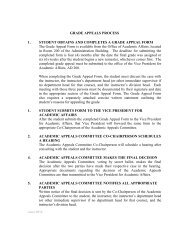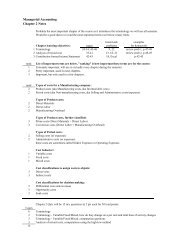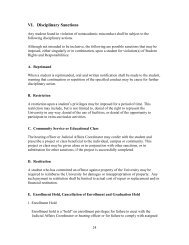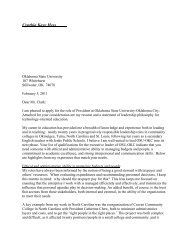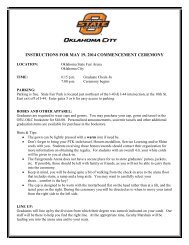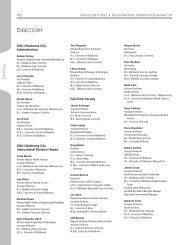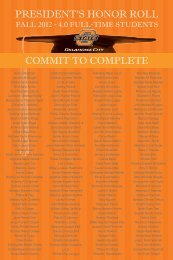Managerial Accounting Chapter 13 Notes Capital Budgeting ...
Managerial Accounting Chapter 13 Notes Capital Budgeting ...
Managerial Accounting Chapter 13 Notes Capital Budgeting ...
Create successful ePaper yourself
Turn your PDF publications into a flip-book with our unique Google optimized e-Paper software.
<strong>Managerial</strong> <strong>Accounting</strong><br />
<strong>Chapter</strong> <strong>13</strong> <strong>Notes</strong><br />
<strong>Capital</strong> <strong>Budgeting</strong> (generally an investment in a long-term asset) decisions.<br />
In my opinion, the two best methods for decision making are:<br />
1) Present value analysis (PV) (p 581-587 and 590-595)<br />
2) Internal rate of return (IRR) (p 587-590)<br />
Refer to problem <strong>13</strong>-6 on page 608. Rather than doing the required (simple rate of return), I will solve according to<br />
Present Value (PV) and Internal Rate of Return (IRR) methods.<br />
I also changed the cost of the machine to $100,000 (at $80,000 the IRR was > 25%).<br />
(95,000)<br />
23,000 23000 23000 23000 23000 23000 23000 23000 23000 23000<br />
|------------------ ------|------ ------|------ ------|------ ------|------ ------|------ ------|------ ------|------ ------|------ ------|------ ----------|<br />
0 1 2 3 4 5 6 7 8 9 10<br />
Cash outflows:<br />
Cash inflows:<br />
Buy new machine 100,000 Operating costs of old 33,000<br />
Trade-in old (5,000) Operating costs of new (10,000)<br />
Net cash out 95,000 Annual savings 23,000<br />
Present value analysis (assuming we need to make 14% minimum).<br />
PV of annuity; 14%, 10 periods (years) = 5.216<br />
x 23,000<br />
119,968 Present Value of future cash flows<br />
- 95,000 Investment<br />
24,968 Net Present Value of Investment<br />
Do we buy the equipment Yes. If NPV of investment is >= zero, then we make<br />
at least the minimum required rate of return (14% in this problem).<br />
Internal rate of return<br />
Calculate where the PV of future cash flows = the required investment.<br />
( $95,000 in this problem) annual cash inflows investment.<br />
23,000 x = 95,000<br />
= 4.<strong>13</strong>0<br />
Now find that factor (4.<strong>13</strong>0) in the PV of annuity table (Table 4 or <strong>13</strong>B-2 in book),<br />
using the number of periods of cash flows (10 years in this problem).<br />
From <strong>13</strong>B-2 on page 630:<br />
20% = 4.192<br />
21% = 4.054<br />
Therefore IRR is slightly above 20%, so we will accept this investment opportunity<br />
as our minimum desired rate of return is the 14% cost of capital.<br />
You do not need to "interpolate" the IRR. Recognizing it falls between 20-21% is close enough.<br />
<strong>Chapter</strong> <strong>13</strong> Quiz:<br />
8 multiple choice, 1 problem<br />
3 mc @ 2 pts, relationship between NPV, IRR and PI (profitability index)<br />
3 mc @ 3 pts, calculate PI, rank projects based on PI<br />
2 mc @ 4 pts, calculate NPV, calculate IRR<br />
1 problem @ 7 pts, calculate NPV (with salvage value)
ACCT2203 - <strong>Chapter</strong> <strong>13</strong> Handout<br />
Time value of money concepts: Handout Table Table in textbook<br />
1Future Value of $1 1 n/a<br />
2Future Value of an Annuity 2 n/a<br />
3Present Value of $1 3 <strong>13</strong>B-1 p. 629<br />
4Present Value of an Annuity 4 <strong>13</strong>B-2 p. 630<br />
1) You invest $10,000 in a certificate of deposit (CD) earning 6% per year for 5 years.<br />
What is the maturity value of the investment<br />
Future Value of $1 (Solution = $<strong>13</strong>,380)<br />
2) You put $2000 per year into your retirement account in each of the 30 years you work for the<br />
company. Assuming you average 10% return, how much is in the account at retirement<br />
Future Value of an Annuity (Solution = $328,988)<br />
3) Your child was born today. You want to buy him a $10,000 car when he turns 16.<br />
How much do you need to invest today at 10% to have $10,000 when he turns 16<br />
Present Value of $1 (Solution = $2,180)<br />
4) You wish to have enough at retirement to draw $50,000 per year for 30 years from your retirement<br />
account. Assuming you average 10% return, how much do you need to have in the account at<br />
retirement<br />
Present Value of an Annuity (Solution = $471,350)<br />
<strong>Capital</strong> <strong>Budgeting</strong> decision<br />
Do you buy a machine for $10,000 that will generate $2000 per year of net income for 10 years<br />
- If you desire a minimum average rate of return of 10% <br />
- If you desire a minimum average rate of return of 20%
<strong>Chapter</strong> <strong>13</strong><br />
Handout Examples<br />
Factor Amount FV or PV<br />
1 1.338 $ 10,000 $ <strong>13</strong>,380<br />
2 164.494 $ 2,000 $ 328,988<br />
3 0.218 $ 10,000 $ 2,180<br />
4 9.427 $ 50,000 $ 471,350<br />
<strong>Capital</strong> <strong>Budgeting</strong><br />
Present Value factor: % Periods Factor<br />
Present Value of Annuity 10% 10 6.145<br />
Factor Amount PV of FCF<br />
Present Value of Annuity 6.145 $ 2,000 12,290<br />
Less: Investment required -10,000<br />
Net Present Value of Investment 2,290<br />
Is this an acceptable investment YES<br />
Present Value factor: % Periods Factor<br />
Present Value of Annuity 20% 10 4.192<br />
Factor Amount PV of FCF<br />
Present Value of Annuity 4.192 $ 2,000 8,384<br />
Less: Investment required -10,000<br />
Net Present Value of Investment -1,616<br />
Is this an acceptable investment NO




